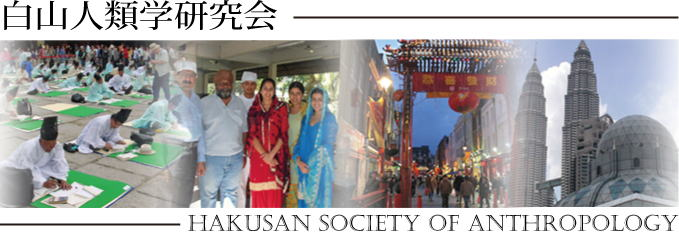 |
| |
|
HOME |
研究会について |
過去の研究会 |
会誌『白山人類学』 |
お問合せ |
リンク |
| |
|
2024年度第6回白山文化人類学研究会(対面・オンラインハイフレックス方式) |
Visual Anthropology as a Research Method: History of Soviet Documentary and Ethnographic Film
発表者:Ekaterina TRUSHKINA(Russian State University for the Humanities)
日時:2024年11月25日(月)18:15〜
対面開催と、Zoomを使用したオンライン開催とのハイフレックス方式にて開催いたします。
参加ご希望の方は以下のフォームからご登録ください。
https://forms.gle/6YxK4zD1MZfe328D7
アクセス用のリンクについては、例会前日までにご連絡差し上げます。
開始の5~10分前にログインしてください。
会場:東洋大学白山キャンパス 9号館 第4会議室
https://www.toyo.ac.jp/nyushi/about/campus/hakusan/
要旨:
The Soviet documentary and ethnographic films are studied as a specific direction of cinema and at the same time as a complex phenomenon expressed by various methodological approaches and interactions between scholars and filmmakers. They also reflect the cultural and national policies of the USSR in the 1920s-1980s. I examine the ethnographic film as the most important cultural practice within the framework of national policy implemented in different periods of the history of the USSR.
The population of the Soviet Union was characterized by its ethnic and religious diversity. The Soviets paid a great attention to the elaboration of cinema as a great tool for mass propaganda and agitation among people. Ethnographic films take its own place closely connected with the nation-building processes and production of the image of a multiethnic Soviet state. The major state film project “The Cinema Atlas of the USSR” (1920s-1930s), initiated by the Soviet government, is a unique series of documentaries, which contributed to the political construction of images of new territories. The project idea was to collect a film almanac of 150 series about the life of different ethnic groups of the Soviet Union. Several film expeditions to different regions of the USSR were initiated. One of the first was organized by the film company “Soviet Cinema” (“СОВКИНО”) and took place in Buryatia. Documentary “Baikal” (“Байкал”, 1928) and fiction film “Storm over Asia” (“Потомок Чингисхана”, 1928) are the unique film documents that expand the boundaries of the research in the field of visual anthropology, as well as in the anthropology of religion, especially Buryat Buddhism.
Late history of ethnographic film in the USSR of the 1960s-1980s is closely connected with the Soviet intellectual culture. It is not easy to determine its boundaries and its place among academic and community practices and a wider range of film lovers and viewers. The research describes the activity of Soviet scholars from the All-Union Music Commission of the Union of Composers USSR (also known as Folklore Music Commission), involved in the process of creating such kind of films (on the example of the film “The Dreamtime” (“Времена Сновидений”, 1982) by A. Slapinsh, E. Novik, E. Alekseev). I also present the data on the practices of film screenings “Folklore on Screen” and organization of the first Soviet Festival of Visual Anthropology (1987).
|
白山人類学研究会世話人
代表:長津一史
運営委員: 左地亮子 ゴロウィナ・クセーニヤ 山田香織
波佐間逸博 田所聖志
お問い合わせは、研究会事務局hakusanjinrui=gmail.com(=を@にかえてください) まで。 |
 |
|
|
| 東洋大学社会学部国際社会学科 〒 112-8606 東京都文京区白山5-28-20 TEL 03-3945-7439 FAX 03-3945-7626 |
Copyright 2021 (c) Department of Global Diversity Studies, Toyo University.
All Rights Reserved. 無断転載を禁ず |
 |
|